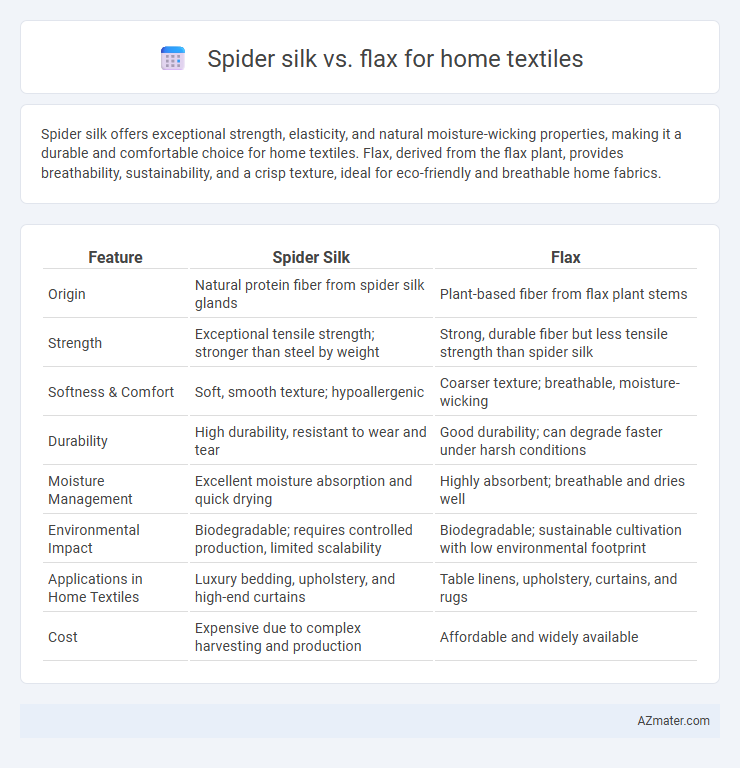Spider silk offers exceptional strength, elasticity, and natural moisture-wicking properties, making it a durable and comfortable choice for home textiles. Flax, derived from the flax plant, provides breathability, sustainability, and a crisp texture, ideal for eco-friendly and breathable home fabrics.
Table of Comparison
| Feature | Spider Silk | Flax |
|---|---|---|
| Origin | Natural protein fiber from spider silk glands | Plant-based fiber from flax plant stems |
| Strength | Exceptional tensile strength; stronger than steel by weight | Strong, durable fiber but less tensile strength than spider silk |
| Softness & Comfort | Soft, smooth texture; hypoallergenic | Coarser texture; breathable, moisture-wicking |
| Durability | High durability, resistant to wear and tear | Good durability; can degrade faster under harsh conditions |
| Moisture Management | Excellent moisture absorption and quick drying | Highly absorbent; breathable and dries well |
| Environmental Impact | Biodegradable; requires controlled production, limited scalability | Biodegradable; sustainable cultivation with low environmental footprint |
| Applications in Home Textiles | Luxury bedding, upholstery, and high-end curtains | Table linens, upholstery, curtains, and rugs |
| Cost | Expensive due to complex harvesting and production | Affordable and widely available |
Introduction to Spider Silk and Flax in Home Textiles
Spider silk, known for its exceptional tensile strength and flexibility, offers innovative potential in home textiles by providing lightweight, durable, and eco-friendly fabric alternatives. Flax fibers, derived from the flax plant, have been used for centuries in home textiles such as linen due to their natural breathability, moisture-wicking properties, and biodegradability. Combining spider silk's superior mechanical properties with flax's sustainable attributes can revolutionize textiles for upholstery, curtains, and bedding, promoting both performance and environmental responsibility.
Origin and Production Processes Compared
Spider silk, derived from the protein-based fibers produced by spiders through a complex spinning process, offers exceptional strength and elasticity unmatched by most natural fibers. Flax, a plant-based fiber obtained from the retted stems of the Linum usitatissimum plant, undergoes mechanical and chemical retting processes to separate fibers suitable for textile production. While spider silk production remains limited due to the difficulties in farming spiders and harvesting silk, flax benefits from well-established large-scale agricultural cultivation and fiber extraction methods.
Material Strength: Spider Silk vs Flax
Spider silk exhibits exceptional tensile strength surpassing many natural fibers, with a strength-to-weight ratio higher than steel, making it one of the strongest known protein-based materials. Flax fibers, while durable and suitable for home textiles, offer lower tensile strength compared to spider silk but excel in rigidity and resistance to wear. The superior elasticity and toughness of spider silk enhance its potential in home textile applications requiring both strength and flexibility, whereas flax provides a more rigid and breathable fabric option.
Comfort and Texture: Feel on Skin
Spider silk offers exceptional softness and a smooth texture, providing a luxurious feel on the skin ideal for high-end home textiles. Flax fabric, derived from flax fibers, has a slightly coarse texture but softens significantly with use and washing, delivering breathability and natural comfort. Compared to flax, spider silk's hypoallergenic properties and moisture-wicking ability enhance skin comfort, making it a premium choice for sensitive skin and delicate applications.
Sustainability and Environmental Impact
Spider silk offers exceptional sustainability for home textiles due to its biodegradability, minimal water consumption, and reduced chemical use compared to conventional fibers. Flax, known for its low environmental footprint, requires fewer pesticides and less water than cotton, making it an eco-friendly option with strong durability and natural breathability. Both materials provide sustainable alternatives by minimizing pollution, supporting renewable resources, and reducing carbon emissions in textile production.
Durability and Longevity in Home Use
Spider silk exhibits exceptional tensile strength and elasticity, surpassing flax in durability for home textile applications. Its natural resilience against wear and tear ensures longer-lasting performance under frequent use, making it ideal for upholstery and bedding. Flax, while strong and breathable, tends to degrade faster with repeated washing and exposure to sunlight, reducing its longevity compared to spider silk.
Hypoallergenic and Health Factors
Spider silk offers exceptional hypoallergenic properties due to its natural protein structure, reducing skin irritation and eliminating common allergens found in synthetic fibers. Flax, derived from the flax plant, is also hypoallergenic and breathable, but its tendency to retain moisture can occasionally harbor bacteria if not properly maintained. Both materials are durable and sustainable choices for home textiles, with spider silk providing superior antimicrobial benefits that enhance overall health and comfort.
Aesthetic Appeal: Colors and Designs
Spider silk offers a luxurious sheen and natural elasticity that enhance the richness and depth of colors in home textiles, creating vibrant and dynamic designs. Flax, known for its matte finish and subtle texture, lends a timeless, earthy aesthetic with soft, muted hues that complement rustic and minimalist interiors. Combining these materials can result in visually striking textiles that balance spider silk's luminous brilliance with flax's understated elegance.
Cost and Market Availability
Spider silk offers exceptional strength and elasticity but remains costly and limited in market availability due to complex production processes. Flax, widely cultivated and cost-effective, provides a sustainable and readily accessible material for home textiles with established supply chains. The economic feasibility of flax makes it a preferred choice for large-scale textile manufacturing, whereas spider silk is primarily reserved for niche, high-end applications.
Future Prospects for Spider Silk and Flax in Home Decor
Spider silk offers exceptional strength, elasticity, and biodegradability, positioning it as a revolutionary material for sustainable home textiles with potential applications in curtains, upholstery, and wall coverings. Flax continues to thrive due to its natural luster, moisture-wicking properties, and eco-friendly cultivation, making it a staple for breathable, durable, and sustainable home decor fabrics. Innovations in bioengineering and textile processing are expected to enhance spider silk production scalability, while advancements in flax fiber refinement will boost its versatility and appeal in future home decor markets.

Infographic: Spider silk vs Flax for Home textile
 azmater.com
azmater.com